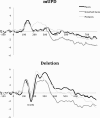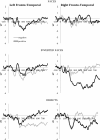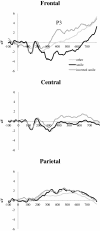Social and emotional processing in Prader-Willi syndrome: genetic subtype differences
- PMID: 23536992
- PMCID: PMC3637538
- DOI: 10.1186/1866-1955-5-7
Social and emotional processing in Prader-Willi syndrome: genetic subtype differences
Abstract
Background: People with Prader-Willi syndrome (PWS) demonstrate social dysfunction and increased risk of autism spectrum disorder, especially those with the maternal uniparental disomy (mUPD) versus paternal deletion genetic subtype. This study compared the neural processing of social (faces) and nonsocial stimuli, varying in emotional valence, across genetic subtypes in 24 adolescents and adults with PWS.
Methods: Upright and inverted faces, and nonsocial objects with positive and negative emotional valence were presented to participants with PWS in an oddball paradigm with smiling faces serving as targets. Behavioral and event-related potential (ERP) data were recorded.
Results: There were no genetic subtype group differences in accuracy, and all participants performed above chance level. ERP responses revealed genetic subtype differences in face versus object processing. In those with deletions, the face-specific posterior N170 response varied in size for face stimuli versus inverted faces versus nonsocial objects. Persons with mUPD generated N170 of smaller amplitude and showed no stimulus differentiation. Brain responses to emotional content did not vary by subtype. All participants elicited larger posterior and anterior late positive potential responses to positive objects than to negative objects. Emotion-related differences in response to faces were limited to inverted faces only in the form of larger anterior late positive potential amplitudes to negative emotions over the right hemisphere. Detection of the target smiling faces was evident in the increased amplitude of the frontal and central P3 responses but only for inverted smiling faces.
Conclusion: Persons with the mUPD subtype of PWS may show atypical face versus object processes, yet both subtypes demonstrated potentially altered processing, attention to and/or recognition of faces and their expressions.
Figures





References
-
- Dykens EM, Cassidy SB. In: Handbook of Neurodevelopmental and Genetic Disorders in Children. Goldstein S, Reynolds CR, editor. New York: Guilford Press; 1999. Prader-Willi syndrome; pp. 525–554.
-
- Milner KM, Craig EE, Thompson RJ, Veltman MWM, Thomas NS, Roberts S, Bellamy M, Curran SR, Sporikou CMJ, Bolton PF. Prader-Willi syndrome: intellectual abilities and behavioural features by genetic subtype. J Child Psychol Psychiatry. 2005;46:1089–1096. doi: 10.1111/j.1469-7610.2005.01520.x. - DOI - PubMed
LinkOut - more resources
Full Text Sources
Other Literature Sources

